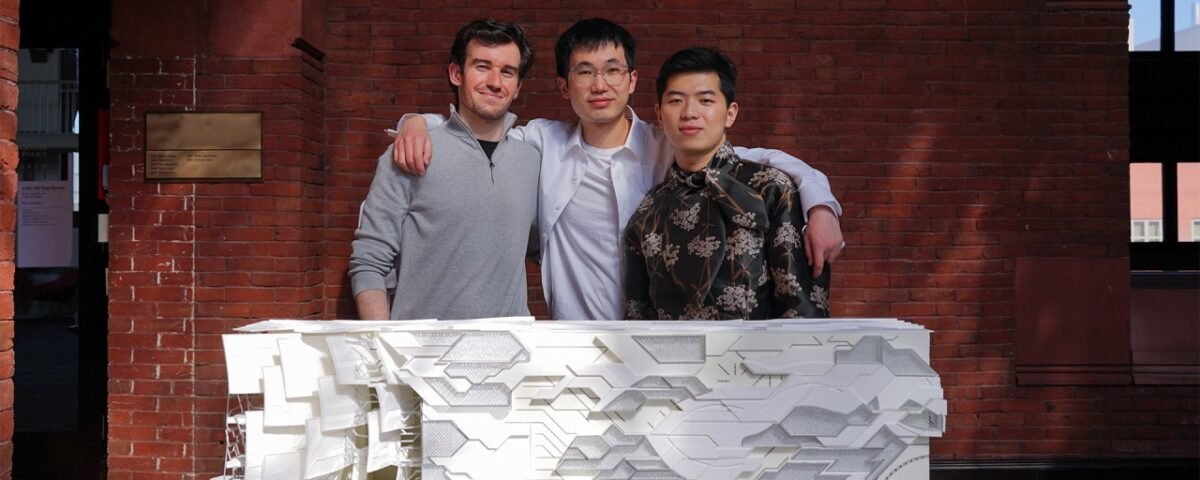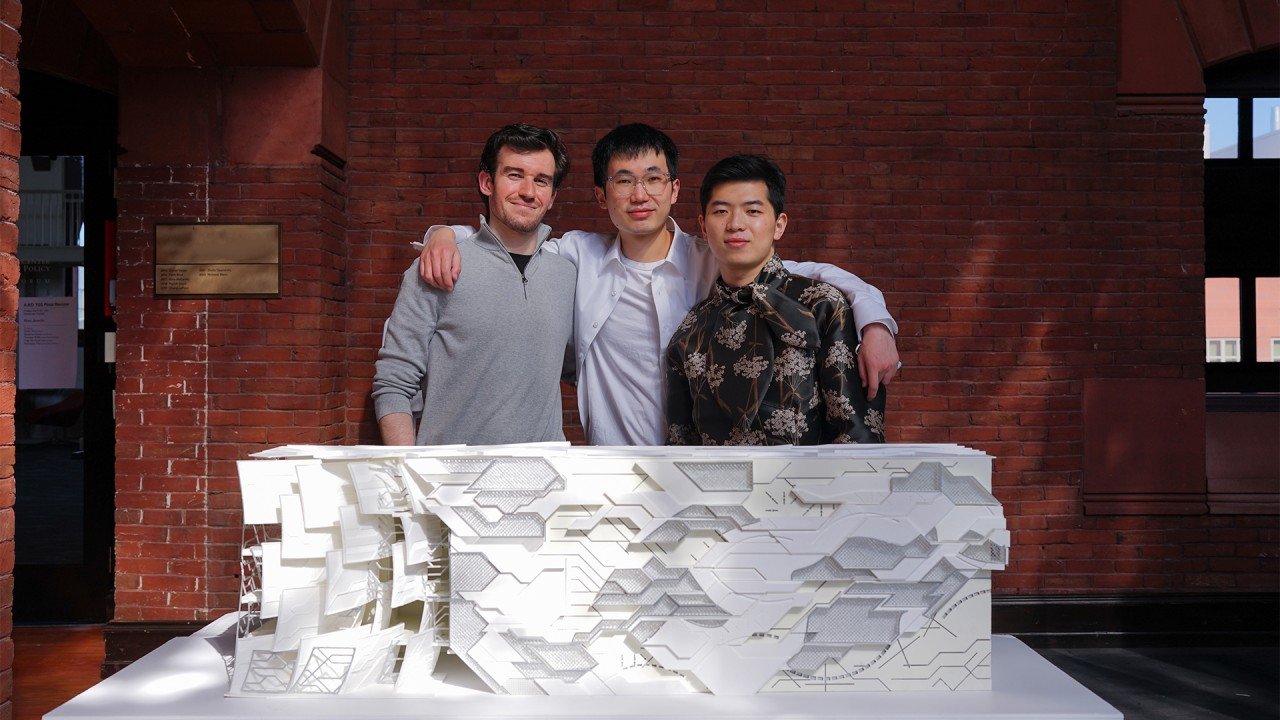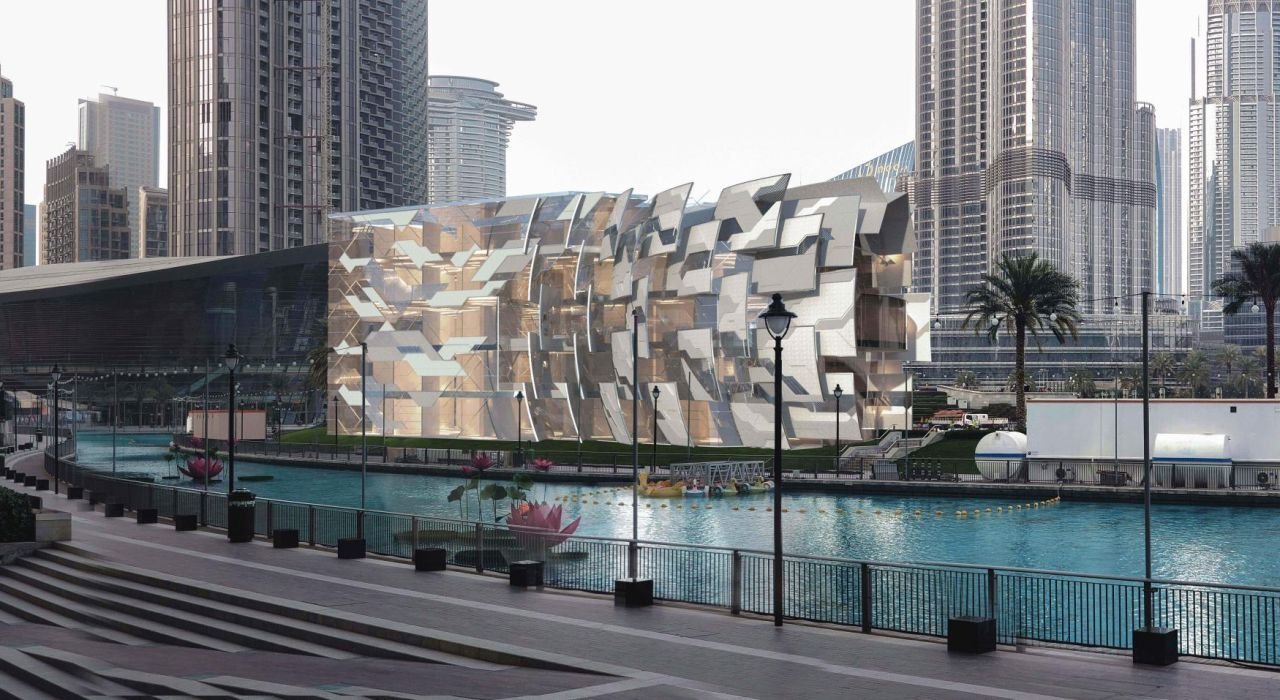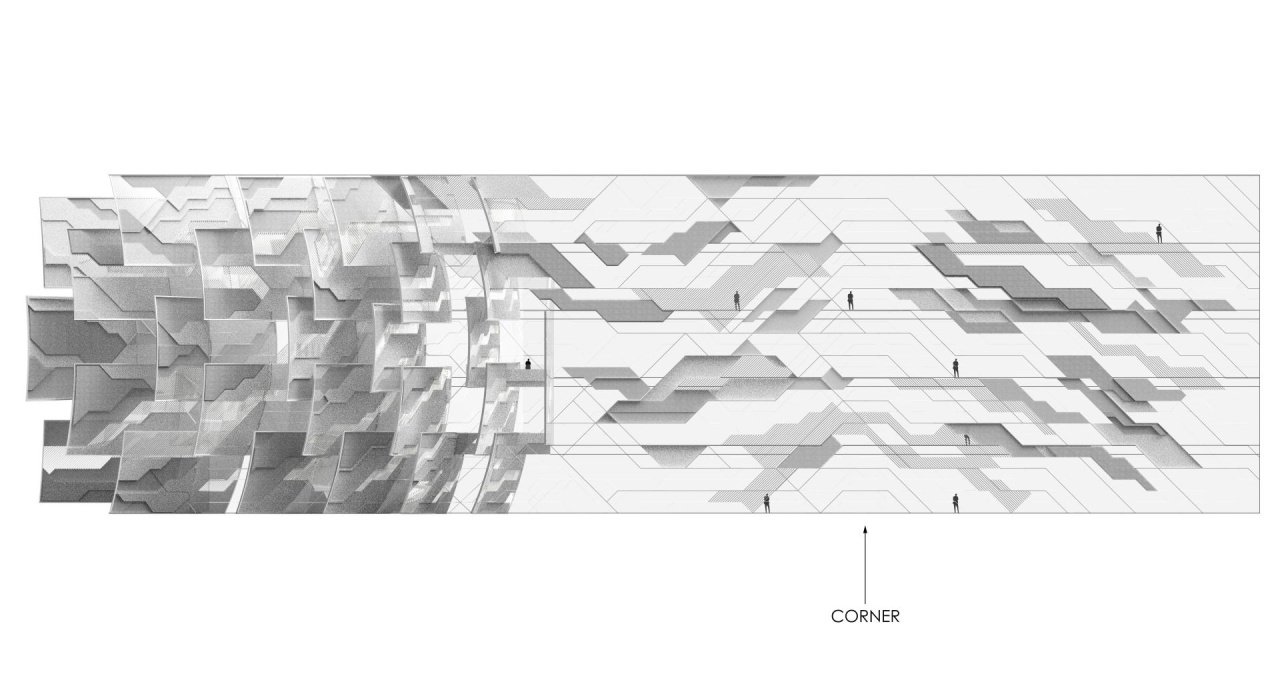
Persephone by Eleven Visualisation: A Living Story in Stone & Greenery
July 23, 2025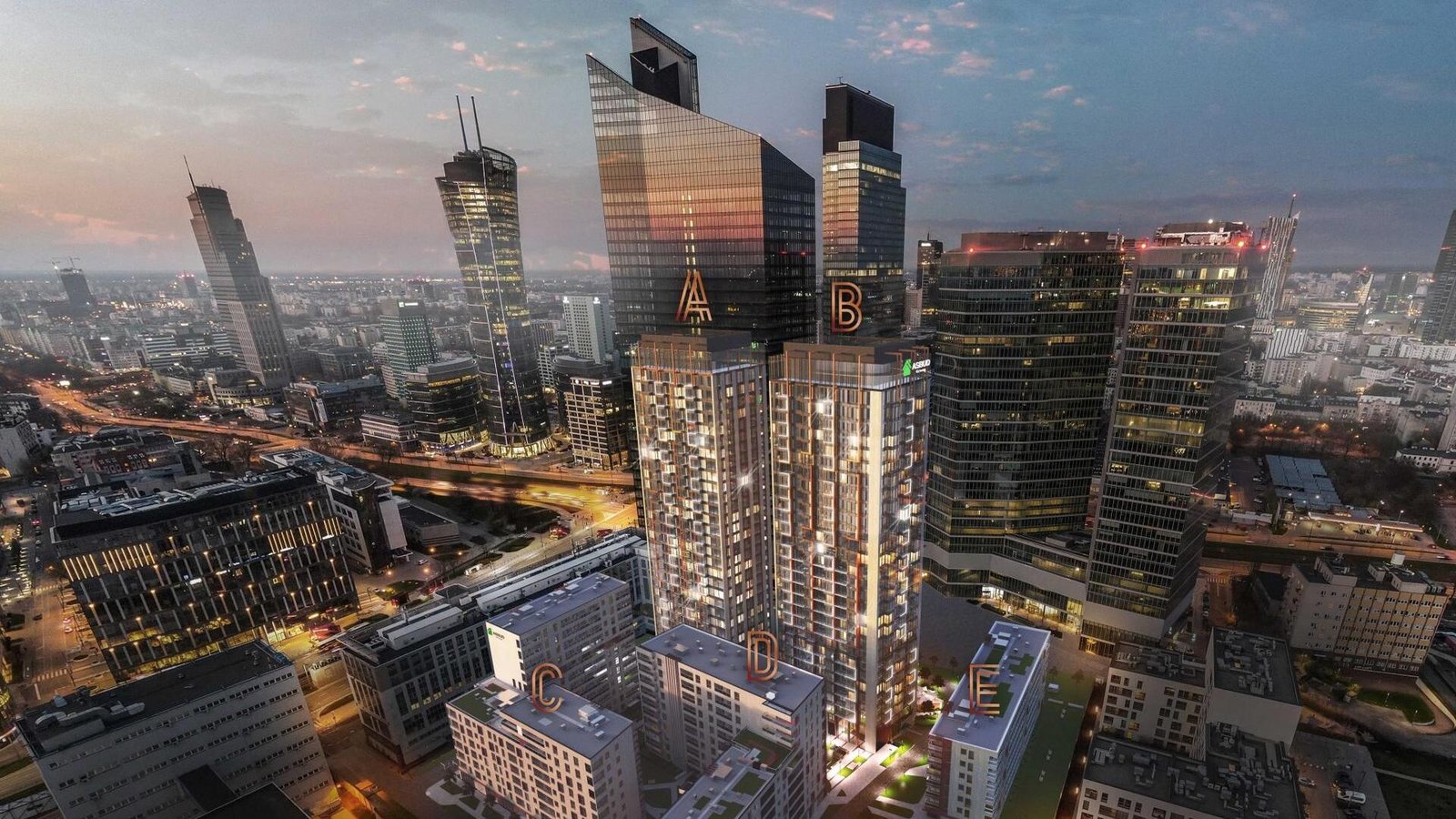
Towarowa Towers | The Epitome of the Heart of Warsaw
July 24, 2025Shen Tao, Bohao Xiong, and Nick Sideropoulos
Shen Tao, Bohao Xiong, and Nick Sideropoulos are the designers behind the Aga Khan Museum concept, each bringing a distinct and deeply personal path into architecture. While Shen explores how space shapes emotion and culture, Bohao draws from hands-on creativity and engineering roots, and Nick channels his passion for turning abstract ideas into built form through focused problem-solving.
Thank you—it’s an honor to share the Aga Khan Museum proposal through this platform. We submitted the project because it attempts to articulate a contemporary architectural language for representing Islamic art and heritage—one that moves beyond replication toward transformation.
The NY Architectural Design Awards provided a thoughtful context to share this vision and contribute to the broader conversation around culture, identity, and spatial expression. The project reflects a design direction we’ve been deeply invested in—blending formal research, computational exploration, and cultural specificity.
It's a meaningful opportunity to engage a wider audience and situate the work within the evolving discourse on museum architecture in culturally layered contexts.
The design centers on the idea of gradient transformation—an architectural shift from clarity to complexity. Drawing from principles of Islamic geometry, we explored pattern, irregularity, and density not as surface motifs, but as spatial tools. We aimed to define the experience of a gradient, specifically a drift in opacity, layering and repetition.
The building’s form evolves from a transparent, gridded mass into a soft, elliptical volume composed of overlapping shingle-like panels. This transformation is meant to echo the intellectual and sensory journey of the museum visitor, moving from structured legibility toward immersive complexity.
Shen Tao: My path into architecture began with an interest in how environments shape experience. Growing up in a small town, I became aware of the emotional texture of space—how light, sound, and sequence create atmosphere. Architecture offered a way to work with those forces directly. It became a lens through which to think about culture, perception, and care.
Bohao Xiong: I’ve always enjoyed building things. As a child, I loved playing with LEGO—not just following instructions, but freely assembling pieces however I liked. I didn’t realize it at the time, but that was an early form of design thinking. Later, through my family, I became more familiar with engineering, and that’s when architecture began to stand out to me. The idea of designing a building—of creating something lasting in a city—felt both exciting and meaningful.
Nick Sideropoulos: For me, the passion for architecture has always been rooted in the magic of turning intangible thoughts into physical form—quite literally, crafting something out of thin air. I’ve also always been someone who gets fixated on a problem until I find a solution, so the problem-solving nature of architecture resonated with me from early on. By the time I was in high school, I already knew I wanted to pursue this field and felt confident I’d enjoy the commitment it requires.
We work as a small, idea-driven team, united by a belief in architecture as both inquiry and craft. Each project is a chance to test how form, context, and meaning can be negotiated with precision. We're committed to design that is rigorous but open-ended, formally controlled but experientially rich.
While our backgrounds and perspectives differ, we share a common interest in producing work that resonates beyond itself, engaging with broader questions of culture, place, and perception.
One challenge was translating abstract geometric research into architectural form without becoming overly literal. We used 2D and 2.5D studies—some assisted by machine learning—to explore how order dissolves into softness. The risk was formal excess; we had to constantly pare down and recenter the spatial intent.
This tension between control and intuition became central to the project’s evolution. It required continuous internal critique to ensure each decision supported the overall spatial narrative. In the end, this process sharpened our clarity: each move had to be justified by spatial experience, not just visual pattern.
Shen Tao: It often begins with a conceptual provocation—sometimes textual, sometimes diagrammatic. I usually start by mapping the initial logics through modeling and drawing, which helps clarify the formal stakes. In parallel, we begin exchanging early thoughts as a team to test direction and coherence. For me, design is a way of thinking through form—calibrating relationships between geometry, program, and atmosphere until they begin to resonate as a whole.
Bohao Xiong: For me, it often starts with a question—sometimes abstract, sometimes material. I like to begin by framing a hypothesis, then testing it through sketches or small studies. If the idea still holds under pressure, I bring it into conversation with site conditions, program, and collaborators. I tend to alternate between wide exploration and focused refinement. It’s rarely a straight path, but I’ve learned to value the moments when the project resists or changes shape. Those shifts usually tell you something important.
Nick Sideropoulos: I usually start by sketching out the basic concept, even if it’s just a few loose lines to break the inertia. Getting started is always the hardest part, so I try to externalize something quickly before tackling bigger questions like materiality. For this project, each of us began with our own line of thought, but we came together early on to exchange ideas and build a direction collaboratively.
One of the most meaningful responses came from peers who described the project as “quietly intricate”—a phrase that captured something we were aiming for. It suggested that the formal restraint and internal complexity of the design were both legible and felt.
When observing our physical model, several people noted how the project seemed to shift as they moved around it, revealing new readings depending on distance, light, or sequence. That sense of temporal depth was something we hoped to achieve, and it was encouraging to see it reflected in others’ perceptions.
It’s a meaningful affirmation that architecture rooted in research, reflection, and cultural nuance still resonates. For our team, it celebrates a process that combines digital experimentation with careful intuition.
Being recognized at this point—while we continue to define our trajectory in the field—reinforces our belief in thoughtful, intentional design. It also encourages us to keep questioning how architecture can represent, not just resemble, tradition.
Shen Tao: It affirms the importance of depth and deliberation in the design process. I hope it leads to new opportunities to engage with institutions or communities that value thoughtful transformation over stylistic trends. It also gives our team a clearer platform to explore ideas that sit between cultural specificity and architectural innovation.
Bohao Xiong: I see it more as a quiet encouragement than a turning point. The kind of work I hope to continue doing isn’t always flashy, and sometimes that means it doesn’t immediately stand out. So having this project recognized reassures me that there’s space for thoughtful, layered work—and that clarity doesn’t have to be loud.
Nick Sideropoulos: This recognition pushes me to keep refining design methods that bridge historical and cultural composition with new technologies. I’m especially interested in integrating tools like machine learning into forward-thinking strategies.
Shen Tao: I’d love to design a space where geometry and acoustics come together—perhaps a performance or prayer hall where structure and sound are deeply integrated. The ambition would be to design not just for the eye, but for the ear and the body. I’m fascinated by how architecture can choreograph stillness and intensity at the same time.
Bohao Xiong: Like many designers, I wish I could bring every idea to life. For me, that includes both conceptual thoughts and material-driven studies—whether it’s an abstract idea that transforms into spatial language, or a texture or detail sparked by a material experiment. The inspiration behind them varies: some come through deep design research, others just arrive—unexpected, like during a shower. But that mix of the intuitive and the analytical is what keeps the process alive for me.
Nick Sideropoulos: One idea that’s stayed with me comes from an earlier project that explored a permeable, self-supporting roof—part structure, part landscape—spanning both new and existing buildings to create a faux-subterranean urban ecosystem. I drew inspiration from the Córdoba Cultural Center in Argentina, and its approach continues to shape how I think about form and inhabitation. I’m also drawn to adaptive reuse—the idea that historic buildings can be preserved and transformed to meet contemporary needs without losing their essence.
Shen Tao: I see a shift toward hybrid practices, where research, digital tools, and cultural narratives intersect in new ways. The field will increasingly ask architects to act as both interpreters and editors, navigating between data, material, and meaning. I hope to contribute by deepening the dialogue between form and cultural specificity, especially in projects that move between the global and the local.
Bohao Xiong: As technology, material innovation, and AI continue to evolve, I see architecture becoming more responsive and interactive. Buildings may shift from static entities to dynamic systems—living platforms that react to human presence. Yet amid these changes, my approach remains rooted in people. I believe in designing for human needs and emotions. However advanced silicon-based intelligence becomes, I still feel a stronger connection to the empathy and complexity of carbon-based life.
Nick Sideropoulos: I believe the role of technology in shaping architecture will continue to expand—especially through smarter materials, robotics, and computer vision. I’m interested in the fabrication and manufacturing side of the field, and I hope to contribute by helping integrate those tools into design education. Ideally, I’d like to teach at the collegiate level, showing future designers that buildings are not just forms, but assemblies of intricately coordinated elements.
Shen Tao: We believe sustainability begins with attention—careful material choices, minimal reliance on mechanical systems, and forms that respond to climate through geometry. But also emotional sustainability: spaces that invite care, aging, and adaptation. In this project, shade, mass, and lightwork were treated as passive responses before anything technological was introduced.
Bohao Xiong: I think sustainability has to be more than just energy metrics—it’s also about emotional and cultural longevity. If a space makes people feel calm, grounded, or seen, they’re more likely to care for it over time. I try to design with that kind of durability in mind. Restraint matters: using just enough, shaping light and shadow carefully, and allowing buildings to age with grace.
Nick Sideropoulos: I continue to explore advanced fabrication methods that involve robotics and sustainable materials—such as architectural clay and bio-based plastics. My goal is to integrate these techniques into design as a primary driver, using autonomous manufacturing to improve energy efficiency and reduce construction timelines.
Shen Tao: A contemporary library for displaced archives—texts and objects that have lost their original home. It would be a space of recovery and reinterpretation. I’m drawn to the idea of designing for cultural fragments—architecture that protects, recomposes, and offers continuity without pretending to restore what’s been lost.
Bohao Xiong: I would design a shelter. A space that offers protection, dignity, and care—for the homeless, for teenagers who’ve run away, for women escaping domestic violence, or for those persecuted for speaking up. A place where anyone can feel safe. To me, architecture at its best is about empathy. It’s about building not just structures, but support.
Nick Sideropoulos: I’d love to design in a context beyond Earth—where gravity is optional, and form is no longer constrained by terrestrial conditions. Inspired by science fiction, I’m interested in what architecture might become when conventional structure gives way to spatial systems shaped by movement, light, and artificial environments. Whether in collaboration with space agencies or new technologies, that kind of challenge would expand the very definition of architecture.
Winning Entry
New Aga Khan Museum of Islamic & Contemporary Art in Dubai | 2025 NY Architectural Design Awards
Set in Dubai, this design proposal for the New Aga Khan Museum envisions a contemporary institution dedicated to Islamic art, science, and cultural heritage. Rather than replicating traditional forms, the project draws from the underlying principles of Islamic geometry... (read more here)
Shen Tao, Bohao Xiong, and Nick Sideropoulos
Shen Tao, Bohao Xiong, and Nick Sideropoulos are the designers behind the Aga Khan Museum concept, each bringing a distinct and deeply personal path into architecture. While Shen explores how space shapes emotion and culture, Bohao draws from hands-on creativity and engineering roots, and Nick channels his passion for turning abstract ideas into built form through focused problem-solving.
Read more interviews through Smart Spaces, Smarter Cities: Mengyao Ye’s Design Mindset here.

